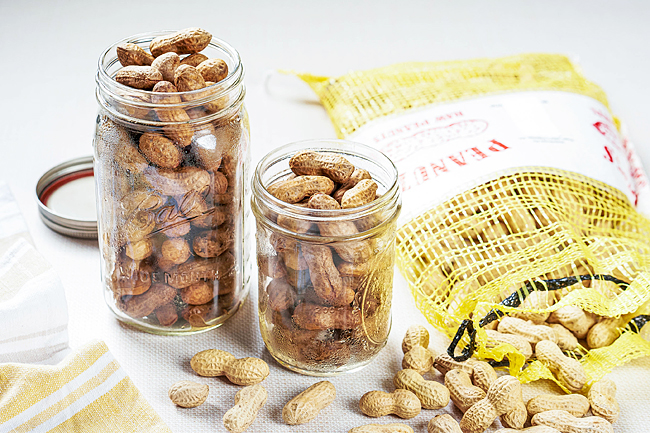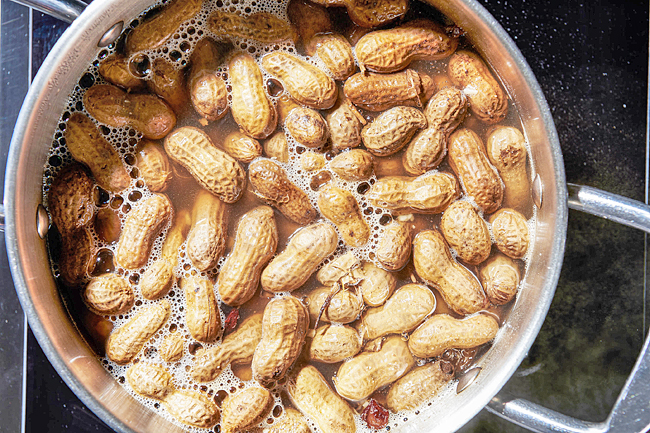THE WASHINGTON POST – If there’s anything that makes me feel homesick, it’s the scent of boiled peanuts.
Although I grew up primarily outside the South, my family moved to Central Florida when I was in high school, and it was there that I discovered the region’s ubiquitous snack food, bubbling away gently in 30-gallon oil drums set over an open flame at roadside stands and flea markets.
Hand over a couple of dollars and you received a 32-ounce foam cup filled to the brim with hot, salty peanuts still in the shell; I loved the soft pop the wet shells made as I squeezed them between my thumb and forefinger, the juice running down my wrist as I savoUred the fleshy texture of the tender peanuts inside. Decades later, whenever I head South to visit my parents, getting a cup of boiled peanuts is always at the top of my to-do list.
While boiled peanuts were a new concept for me as a teenager from the Northeast, they were a taste of home for chef Vishwesh Bhatt when his family moved from Gujarat, India, to Austin when he was 17. “I grew up eating boiled peanuts,” Bhatt said. “My mother would make them in the pressure cooker with salt, lemon, ginger and green chillies, so when I came here and saw boiled peanuts on the menu, it felt familiar.”
Boiled peanuts in the South tend to be cooked simply, with just salt and vinegar added to the water, and eaten just as simply – a snack straight from the shell. But once we remember that peanuts are actually legumes, a boiled peanut can shift from a snack to a centrepiece.
Canadian-born chef Hugh Acheson, owner of Five & Ten restaurant in Athens, Georgia, said reframing the peanut this way opens the door to new preparations. “Sometimes when we look at food from one perspective, we are pigeonholing it.”


For Acheson, this might mean boiling raw peanuts with star anise and a seafood seasoning such as Old Bay, then using them in a reimagined hummus or falafel. “The closest affiliation we have to boiled peanuts worldwide is jarred or canned fava beans,” he said, “so it’s an easy stretch to substitute them anywhere you might use the fava.”
Originating in South America, peanuts had been spread by traders around the world by the 17th Century; enslaved Africans brought them to the American South, where they were typically grown for livestock or as a protein source for those in bondage and for the poor, before gaining more widespread popularity during the Civil War and through the later work of agricultural scientist George Washington Carver. Confederate soldiers even sang about “goober peas” – boiled peanuts – in a popular wartime ditty.
Beyond the rural South, however, boiled peanuts became a favourite preparation in many cultures, including in zongzi, a Chinese sticky rice dumpling often stuffed with boiled peanuts, and Bolivia’s traditional sopa di mani, a chunky soup of boiled peanuts, potatoes, pasta and peas. In Hawaii, peanuts are boiled with star anise and Hawaiian red sea salt, while a Ghanaian dish of mashed papaya, fresh corn kernels and boiled peanuts highlights the legume’s natural sweetness.
At Snackbar, the globally influenced Southern restaurant that Bhatt helms in Oxford, Missouri, you might find boiled peanuts in chaat, a category of Indian food ranging from snacks to small plates in which there must be a combination of textures and flavours: crunchy, creamy, spicy, sweet, sour, salty. The boiled-peanut chaat in Bhatt’s cookbook, I Am From Here: Stories and Recipes From a Southern Chef, features fresh tomatoes, red onion and cucumbers combined with fresh herbs and toasted spices, with the boiled peanuts playing a distinctly bean-like role.
“One of the greatest ways of using them is in a salad,” Bhatt said, “but any dish that uses roasted peanuts points us towards flavours that work with boiled peanuts as well. When you think about Thai food, basil and peanuts are a natural combination, so try using boiled peanuts in a pesto instead of pine nuts.”
Indeed, peanuts are a natural partner for many sweet and savoury ingredients. Boiled with vegetable stock, cola and ancho chillies, they can become a savoury-spiced accompaniment to the protein of your choice, whether shrimp or tofu. Chill gingery boiled peanuts to toss with rice noodles, fresh lime juice and a splash of toasted sesame oil, or mix them with maple syrup to top off an ice cream sundae instead of wet walnuts.
Boiled peanuts can be an acquired taste for the uninitiated, said Acheson, who couldn’t even wrap his head around the concept of pimento cheese when he first arrived in the South: “Cheese mixed with mayonnaise was definitely off-putting to me, and boiled peanuts seemed just as strange.”
As he began to experiment with the ingredient, he found that adding lightly crushed boiled peanuts to a beurre blanc for pan-roasted flounder allowed him to play with the texture of the softened peanuts against the crispy exterior of the fish.
“It’s such a wonderful basic food in so many ways,” Acheson said. “We just need to get away from the concept of it being a nut and treat it like the legume that it is. Boiling peanuts just opens up new possibilities.”
BOILED PEANUT DIP
In this twist on hummus from Acheson, boiled peanuts are treated like the legumes they are, standing in for the traditional garbanzo beans.
When boiled, peanuts’ flavour is more subtle than when they’re roasted.
The resulting dip will not taste overwhelmingly peanutty, so if you want to amp up the peanut flavour, substitute a half tablespoon of peanut butter – or more – for a portion of the tahini.
Make Ahead: If you want to cut the cooking time by half, soak the peanuts for several hours and up to 12 hours before boiling.
Storage: Refrigerate the dip for up to seven days. Refrigerate the boiled peanuts for up to seven days or freeze in an airtight container for up to three months.
The raw peanuts in the shell can be stored in an airtight container in a cool, dry place for up to six months.
INGREDIENTS
For the boiled peanuts
One gallon water
Quarter cup apple cider vinegar
One tablespoon fine salt
One tablespoon seafood seasoning
Two whole star anise pods
One pound raw unshelled peanuts, about six cups
For the dip
One cup shelled boiled peanuts
One medium clove garlic, chopped
Two tablespoons well-stirred tahini
One tablespoon fresh lemon juice
Quarter teaspoon ground cumin
One-eighth teaspoon cayenne pepper
Two tablespoons olive oil
Two tablespoons water, plus more as needed
Fine salt (optional)
DIRECTIONS
Boil the peanuts: Find a heatproof plate or pot lid that is just smaller than the diameter of your large stockpot and set it near your work area.
In the large stockpot over high heat, combine the water, vinegar and salt and bring to a boil. When the water comes to a boil, stir in the seafood seasoning and star anise, then add the peanuts.
Place the reserved plate or lid on top of the peanuts to weigh them down a bit.
Cover and decrease the heat so the liquid is at a simmer and cook until the peanuts are very tender, about six hours. Drain, transfer to a large, rimmed baking sheet and let cool completely.
Shell one cup of the peanuts for the dip, and transfer the rest to jars – you should have five-and-a-half cups – and save for snacks.
Make the dip: In a food processor, combine the boiled peanuts, garlic, tahini, lemon juice, cumin and cayenne. With the motor running on low, if your processor allows, slowly add the olive oil and process until smooth and emulsified. Stir to be sure the mixture is well combined.
Increase to high, then add the water to thin out the dip, processing until the spread is the consistency of hummus. If needed, add more water one tablespoon at a time. Taste, and season with salt, if desired (the peanuts are already salted). Transfer to a bowl and serve with bread, crackers, pickles and/or crudite. – Kristen Hartke





